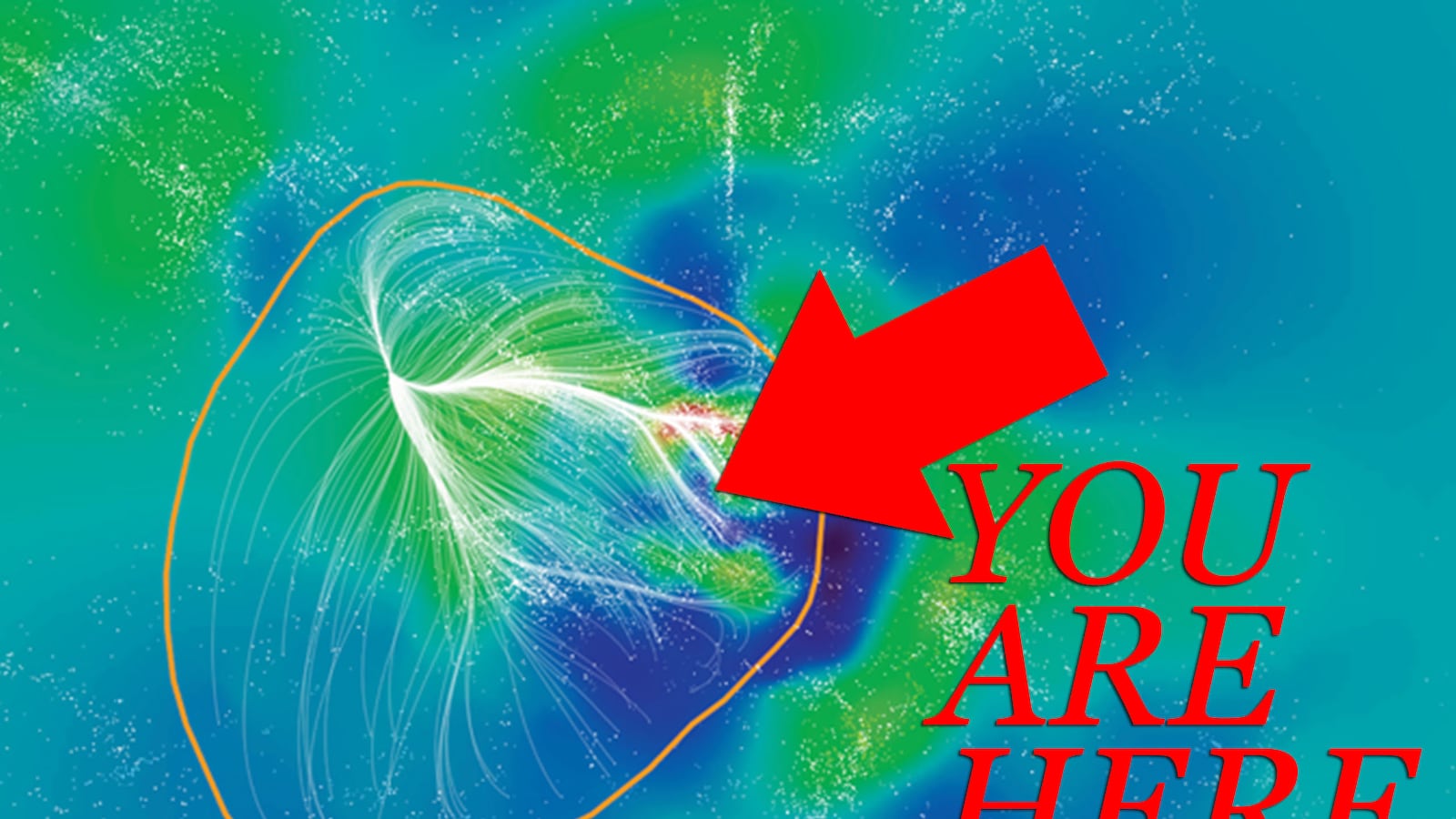Everywhere we look in the cosmos, we see galaxies, forming a thick network that almost looks like cells in the human brain. The cells themselves are galaxy clusters—collections of hundreds or thousands of galaxies bound together by mutual gravity—connected by long filaments. In between are voids—deep regions almost entirely empty of galaxies.
Clusters, filaments, and voids make up the large-scale structure of the Universe, foster-child of gravity and slow time. However, it’s hard to tell exactly where the Milky Way fits into the cosmic network, from our place inside it. Our home galaxy isn’t in a galaxy cluster, but it could lie in a filament on the outskirts of a supercluster—a cluster of clusters—or even inside a void.
Based on a survey of galaxies near ours, astronomers R. Brent Tully, Hélène Courtois, Yehuda Hoffman, and Daniel Pomarède have placed the Milky Way on the fringe of a huge supercluster. By measuring the motion of these galaxies relative to the expansion of the Universe, they found a concentration of galaxies 520 million light-years across, which they named Laniakea, meaning “spacious heaven” in Hawaiian.
It’s a beautiful name for a beautiful picture. However, we shouldn’t get too excited just yet. The shape, size, and very existence of the Laniakea supercluster rest on some controversial ideas, which we should expect to see challenged in subsequent studies. To see why that is, let’s dig into the paper and how these four astronomers discovered Laniakea.
The large-scale structure of the Universe is the result of a conflict between two tendencies. Gravity pulls things together, but the entire cosmos is expanding, pushing galaxies apart. That conflict creates the network of galaxies we observe, and the dark voids between them. While everything on average is moving farther apart, the motion of an individual galaxy may be toward a cluster or other concentration of matter.
That conflict also complicates finding our place in the cosmic network. The Milky Way, along with a number of other galaxies, appears to be moving toward a dense region of space dubbed the “Great Attractor” at a rate faster than cosmic expansion. On the other side of our galaxy, though, there’s a deep empty region known as the Local Void.
Our galaxy isn’t part of a cluster (though it is a member of the small Local Group of galaxies) but it might be part of a supercluster. Unlike galaxy clusters, superclusters are too big to be bound strongly by gravity, and there’s some debate among astronomers about how to define what a supercluster is. In the new paper, Laniakea is defined by a gravitational boundary. The authors estimated the motion of more than 8,000 galaxies from a large observational survey, and subtracted that velocity from cosmic expansion. The remainder is “peculiar” motion: movement of galaxies as dictated by the presence of matter nearby.
The authors found a watershed (in their metaphor), a boundary where the average motion of galaxies changed from being toward each other to moving apart. In this model, everything inside that watershed is part of the Laniakea supercluster: a huge bean-shaped region 520 million light-years across, containing mass equal to 100 quadrillion Suns.
As the Universe expands, Laniakea will break up into smaller collections of galaxies, so some astronomers dispute whether it should be called a supercluster at all. Like Phil “The Bad Astronomer” Plait, I’m not particularly concerned with the precise definition of a supercluster. Let others hash that out. I’m more concerned with another bit of information tucked into the Methods section of the paper.
The size and shape of Laniakea depend on the rate of cosmic expansion, which is described by the Hubble parameter. Like the space telescope, it’s named for astronomer Edwin Hubble, one of the co-discoverers of the expansion of the Universe. Sometimes you’ll see references to the “Hubble constant,” but that’s misleading, since it ain’t constant. The Hubble parameter is a way of associating how fast a galaxy seems to be moving away from us with how far it is, so a large value means a fast rate of cosmic expansion—and a younger age for the Universe.
In this paper, the authors calculated a significantly larger value for the Hubble parameter than the consensus from other observations, such as the Planck cosmic microwave background experiment. Admittedly, different observational methods do turn up some differences in the measured expansion rate, but using a value for the Hubble parameter this large is a bold assertion.
As astronomer Alan Duffy pointed out on Twitter, if you use a smaller value of the Hubble parameter—in line with what other cosmologists use—Laniakea becomes much smaller, and may no longer include the Milky Way. That’s kind of a big deal, so expect there to be more papers discussing Laniakea in the future.
In a sense, we occupy a weird place in the Universe: relatively close to both a void and several huge galaxy clusters. Whether the Milky Way is part of a supercluster, inside a void, or somewhere in between, our region of the spacious heavens is anything but boring.
Thanks to astrophysicist extraordinaire Katherine Mack for helpful discussions in putting this article together.






